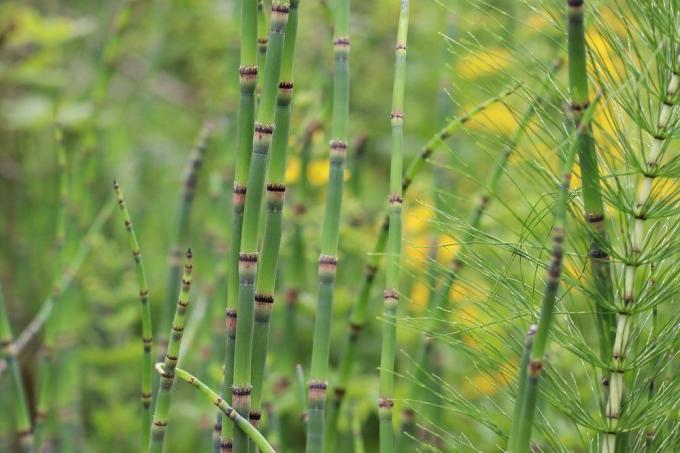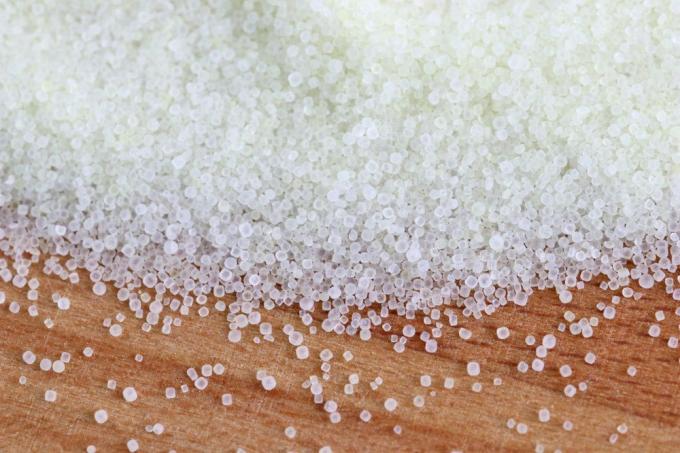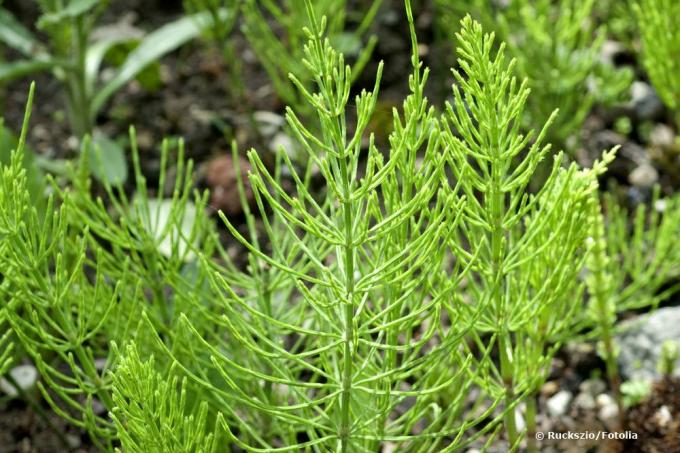
table of contents
- 7 home remedies to fight horsetail
- 1. Remove rhizomes
- 2. Hot water
- 3. Limescale
- 4. Spread fertilizer
- 5. mowing
- 6. Regular pruning measures
- 7. Create shadows
- Avoid certain home remedies
For many gardeners, horsetail is a valuable plant which, due to its properties, is used for a variety of applications. However, it can happen that the horsetail (bot. Equisetaceae) spreads too much, displaces other plants and becomes one weed advanced. If that is the case, many gardeners want to put an end to the cat frond, but this is not that easy. Because chemical agents are poorly suited to combating the rhizome-forming geophyte, it is home remedies and classic gardening steps that are effective against the plant. Especially in sunny and warm areas there is often a strong spread of the plant, as it is a true sun worshiper. But you can make use of this, because the field horsetail is being tackled mainly by the change in its current location.
7 home remedies to fight horsetail
Horsetail is a stubborn plant that is not easy to control. The reason for this is that
rhizomethat can spread rapidly within a short period of time and, especially when the conditions are favorable, establish themselves as one of the predominant "weeds" in unkempt gardens. If you want to tackle this, there are several “home remedies” that you can use. Some of them are actually just classic care measures, because field horsetail rarely or not at all settle in a well-tended garden. The following home remedies will help with an infestation:
1. Remove rhizomes
Removing the rhizomes by hand is the best, but also the most physically demanding solution. This measure is always combined with a Soil improvement, because compacted or waterlogged soils are the ideal location for the robust horsetail plants. Because of this, digging up the site not only allows you to remove the pesky rhizomes, but also incorporates fresh substrate and a drainage material such as sand. The following points explain this process a little more clearly:
- dig up effectively in young specimens
- extremely exhausting and time-consuming for older people
- dig up the earth with spades and shovels
- Exposing rhizomes
- remove by hand
- alternatively use scissors or saws
- Work in drainage
- Work in fresh substrate or fertilizer
If the cat's tail has been in this location for a long time, digging it up is almost no longer worthwhile. Then the only thing left to do is to regularly dig up the earth and work in good drainage. This allows other plants to settle and drive out the field horsetail, which will no longer feel comfortable in this location anyway.
2. Hot water
Yes, hot water is a classic in the garden and can be used just as effectively against horsetail. You simply have to pour boiling water over the visible parts of the plant. These are then received and can be easily removed. However, you have to combine this measure with removing the rhizomes, otherwise the plant will keep forming new stalks. With young plants, however, boiling water can work if it destroys the not yet so strong rhizomes. However, this is not so easy to see as they reach quite deep into the ground.
3. Limescale
Since field horsetail does not tolerate lime, you can make life difficult for the plant simply by watering it with lime-containing tap water. Nevertheless, tap water has only a minor effect on the robust cat frond. Therefore, you should also lime to accelerate the effect. Just bring classic Garden lime periodically on the site and the plant will wither over time. However, be careful not to use this method if you have plants that are sensitive to lime, such as plants in the immediate vicinity Rhododendrons are located.
4. Spread fertilizer
Since the cat frond is a pointer plant, you can assume that your soil can not only be compacted or poor in lime, but also poor in nutrients. The horsetail thrive splendidly in poor soils and for this reason it has proven to be cheap proven to enrich the soil with sufficient fertilizer to make the location inedible for the plant do. The following fertilizers are best established for this purpose:
- composted horse manure
- ripe compost
- Horn shavings
- Bone meal
- Artificial fertilizer (containing nitrogen)
You have to enrich the soil at the location of the field horsetail with these fertilizers and after a short time you will realize that the plant is not doing well. The excess nutrients eats away at the plant and through the additional tillage you can also remove some of the rhizomes.
5. mowing
One of the best-known methods to keep unwanted weeds out of the race removing is proper mowing. This will prevent the plant from getting enough light and growing vigorously enough to spread further. This method has been used for years to keep the lawn free of weeds and unwanted plants. However, you can't just pick up the lawnmower and get started right away. The following points will help you to take effective action against the growth in your lawn:
- mow every eight to 14 days
- water thoroughly while waiting
- there must be a closed lawn cover
- never mow less than four centimeters
- four to eight centimeters are recommended
- Simply leave the grass clippings where necessary
- repeat all summer
- Re-sow in autumn
The reason for this cutting height is the amount of light. The taller the blades of grass, the less light the young horsetail plants get and the less effective they are in sprouting. Over time, they wither and are simply removed when mowing. You should therefore never mow less than four centimeters, otherwise this effect cannot work. If your lawn still needs some nutrients, you can simply leave the clippings lying around. This also causes a lack of light in the herbs.
6. Regular pruning measures
What many people forget is the independent reproduction of horsetail via spores. Since they have no flowers, shoot axes are formed, from which spores are expelled in spring from March to April. You have to take care of this in order to prevent it from spreading to other places. Although the spores only reproduce annually, even far-away corners of your garden can be reached. To keep the plant from spreading via spores, do the following:
- choose sharp scissors
- In the spring, cut all specimens generously back to the ground
- Dispose of the shoot axes on the compost
- alternatively in household waste
- just to be on the safe side
- it is best to prune again in summer and autumn
- be as thorough as possible

You cannot destroy the existing field horsetail with this measure. To do this, protect the rest of the garden from the aggressively spreading plant. This is important because this is the only way to prevent the horsetail invasion in the long term.
7. Create shadows
As simple as it may sound, shade works very well against the sprouting of field horsetail. The reason: the plant needs a lot of sunlight to thrive and dies quickly due to a lack of light. So if you have the opportunity to provide the infested area in the garden with shade, you should do so immediately. Above all, a sudden loss of sunlight is hard on the plant and you can thus contain the spread and then get the rhizomes out of the ground.
It is very rare for field horsetail to slide between road slabs or cobblestones. If that is the case, you can remove the surface effectively with a flame-cutting device. Otherwise, you should be very careful with all of the above methods, as even small mistakes or carelessness will cause it to spread again. The stubborn growth is not to be trifled with, especially if you have neglected your garden for a long time. You will achieve the best result by combining several of the above home remedies. An example:
- boiling water
- Dig up the ground
- Work in drainage and fertilizer
- provide shade
This combination works wonders in the long run. Field horsetail cannot be defeated immediately, but the robust plant can be conquered with patience.
tip: If you choose an herbicide instead of home remedies, you will not enjoy it for long. The products work effectively on the field horsetail, but only on the part above the ground, while the rhizomes survive and can sprout again suddenly.
Avoid certain home remedies
There are other classic home remedies that have been used for decades to combat field horsetail. However, due to their side effects on the soil quality, these are strictly controlled or it is simply forbiddento use them in private use. We're talking about:
- salt
- Vinegar and vinegar essence

As such, there is nothing wrong with using these products on your own lawn or in the vegetable patch. Nevertheless, these have such a strong impact on the soil that many sensitive plants can no longer be planted there for years. Examples would be:
- Strawberries (bot. Fragaria)
- rhododendron (bot. Rhododendron)
The use of salt and vinegar is also prohibited on all surfaces that you do not use for horticultural purposes, such as your terrace or paved paths. Since these do not allow it to seep into the ground, household remedies end up in the wastewater and are therefore prohibited by law on these surfaces. Using it on your lawn or in the vegetable patch is not against the law, but it is not recommended in any way if you want to continue using the soil there.
tip: There is also a potential hazard from the use of vinegar and salt as weed killers on groundwater. If you control large specimens of horsetail with vinegar or salt with a high amount of these agents, they can get into the groundwater and contaminate it.





